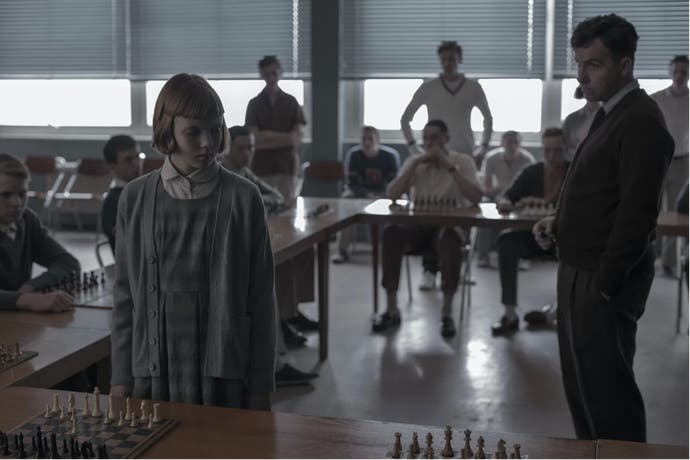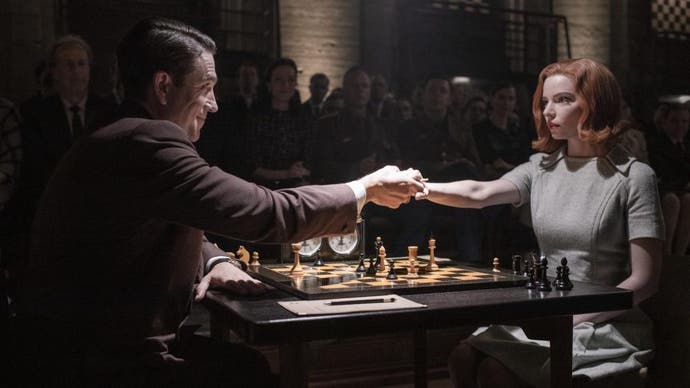The Queen's Gambit is a love letter to play
Spoilers ahead!
This piece contains spoilers for the entirety of The Queen's Gambit.
A confession: I am quite terrible at chess. I do know the rules, but none of the strategy. None of the game. Nevertheless, inspired by the thrilling chess sequences of The Queen's Gambit, a Netflix mini-series about a young chess prodigy, I booted up the chess program pre-loaded on my laptop, positioned the difficulty slider quite generously to my advantage... and lost a bishop within seconds. I'm not sure how it happened. It was there one moment, and then it was gone, like a magic trick. But no matter: poor chess ability is no barrier to your enjoyment of The Queen's Gambit. Not because there isn't much chess in it - there is! It's just that while the surface of the show concerns itself with the particulars of chess, what it's really tapping into is something far more universal. Namely, play.
In his seminal work of game studies Homo Ludens, historian and cultural theorist Johan Huizinga argues that it is not wisdom that defines humanity, but rather play. I came across Huizinga while reading another book, GAMISH: A Graphic History of Gaming by Edward Ross, which is not only a great introduction to game studies but contains a wonderful potted history of chess. The game has been with us in one form or another for over 1400 years and travelled the Silk Roads to become what Steven Johnson calls "one of the first truly global cultural experiences".

In the 20th Century, chess crossed the threshold into the virtual world. After spearheading the fight to crack the Enigma Code, Alan Turing kept himself busy co-creating Turbochamp, a program that could 'play' chess. It was too complex for computers of the time so he had to run the algorithm himself, reading aloud from a printout of the script. Turing was just the latest in a tradition of people trying to create a chess-playing machine. In 1997, IBM's supercomputer 'Deep Blue', capable of calculating 200 million positions per second, finally achieved the impossible: it beat Garry Kasparov in an epic showdown, marking the first time a computer had beaten a Grandmaster.
Today, such technology is commonplace. You can play the 19-times world champion-beating Shredder Chess online right now, but personally I'd recommend someone with a bit more personality:

Not one but seven virtual Beth Harmons are available, each one fine-tuned to represent the fictional chess prodigy at different points of her life. If you do take up the challenge, regardless of how successful you are, you might find something quite magical happen to you.
It's the same thing that happens to you when you dive out of the Battle Bus, when you comb the beach of the world's cosiest desert island or try once more to escape the realm of Hades.
Huizinga describes it as 'stepping out of "real" life into a temporary sphere of activity with a disposition all of its own.' I can't get enough of this phrase. A temporary sphere of activity with a disposition all of its own. You can create one right now by tossing a coin and making a call. The world, for a moment, disappears.
In The Queen's Gambit, Beth uses chess to tap into this 'temporary sphere' in a number of ways. At first, it offers her a sort of intellectual refuge, a space for her vast intellect to stretch its legs. In the first episode, a nine-year-old Beth takes on a dozen or so opponents from the local boys' chess club- simultaneously. "I've never won anything before," she later tells her mentor, Mr Shaibel. It is the first moment of triumph in a very painful life.

Beth's relationship with chess soon turns toxic, however. It quickly becomes entangled with her substance abuse: without a chessboard of her own, she uses tranquilisers to induce hallucinations of chess pieces hanging from her ceiling. This begins the show's examination of 'play' as both a space to become the truest version of yourself and the co-author of your own self-destruction.
As Ross explains in GAMISH, civilisations throughout history have had cause to feel wary about this potentially toxic element of play. The Buddha himself set out a list of games he deemed 'a cause for negligence', including ashatapada - a dice-based precursor to chess. Much of Beth's journey then is about finding a way clear of this toxicity, which brings us to another observation from Johan Huizinga: play has the uncanny ability to make us feel "apart, together".
When we play, when we enter that 'temporary sphere of activity,' we stand apart from the world. But, and I think this is the point upon which Beth's entire emotional journey hinges, we do not have to go alone. We can stand "apart, together," and interact in ways only made possible through play. Competitively or cooperatively, we fight, we bluff, we make decisions, we pull off daring feats of luck and skill.
Even a game like chess can provoke a deep sense of togetherness. In Beth's face-off against Harry Beltik, much of the game plays out on the characters' faces - a deliberate decision, according to the creators. As Beltik's options narrow, his expression grows more and more pained. He is suffering, right up until the point he realises a loss is inevitable. Beth says, "Do you see it now? Or should we finish this on the board?"
And his anguish melts into a smile.
The sphere of activity bursts like a dream, and so good was the dream, so much did it allow him to use his powers to their very limits, that it hardly matters who the victor was.
We see this a number of times throughout the show, none perhaps more cathartically than in 'End Game' where Beth takes on USSR Grandmaster Vasily Borgov for the second time. While we have grown accustomed to watching her vanquished opponents topple their kings in frustration, Borgov (who until this point has seemed rather emotionless), offers his King to Beth with an outstretched hand. She clasps it, unbelieving, and much like Beltik before him, Borgov's sombre expression breaks into a warm smile.

The pieces themselves figure quite largely in the show. As mentioned before, they loom from Beth's ceiling. They are moved slowly and deliberately one moment, frantically the next. Sometimes they do not move at all and the camera lingers on them long enough to make their non-movement seem like an act of physical exertion, like a breath held. Perhaps these abstract pieces hold power because they allow us to see ourselves in them. Perhaps they give us room to imagine something else entirely, like little pots of soil, ready to sprout whatever the situation requires of them. They remind me of the uncanny ability of pixel art to stir emotion, to let our imaginations fill in the gaps.
I feel like all these aspects of play come together at the end of the series when Beth is walking alone through the streets of Moscow. She comes across a group of amateur chess enthusiasts playing in the streets and is challenged to a game by an old man. She is wearing a white coat with a white bobble hat that makes her look like a chess piece - I've seen one person reflect on the symbolism of her resembling a pawn, but to me that bobble makes her look like a queen.

A crowd gathers and a 'temporary sphere of activity' is formed. They are a community, entering the play space together, and even though the result is inevitable, even though Beth can do nothing but destroy her opponent, they know that the real prize is to bear witness to her work.
And then Beth faces the camera and brings the series to a close: "Sygrayem," she says.
Let's play.
